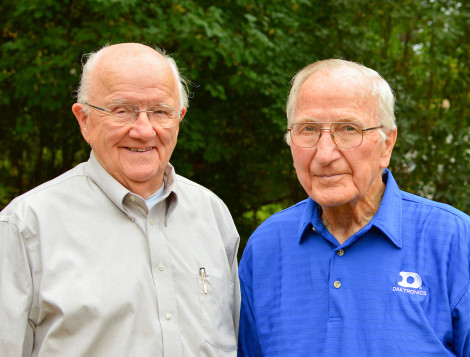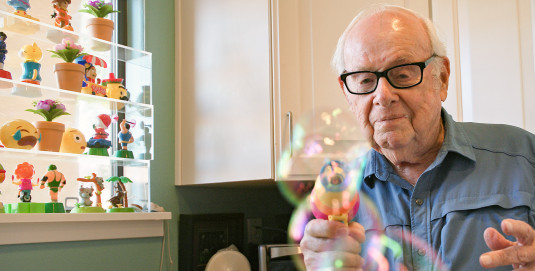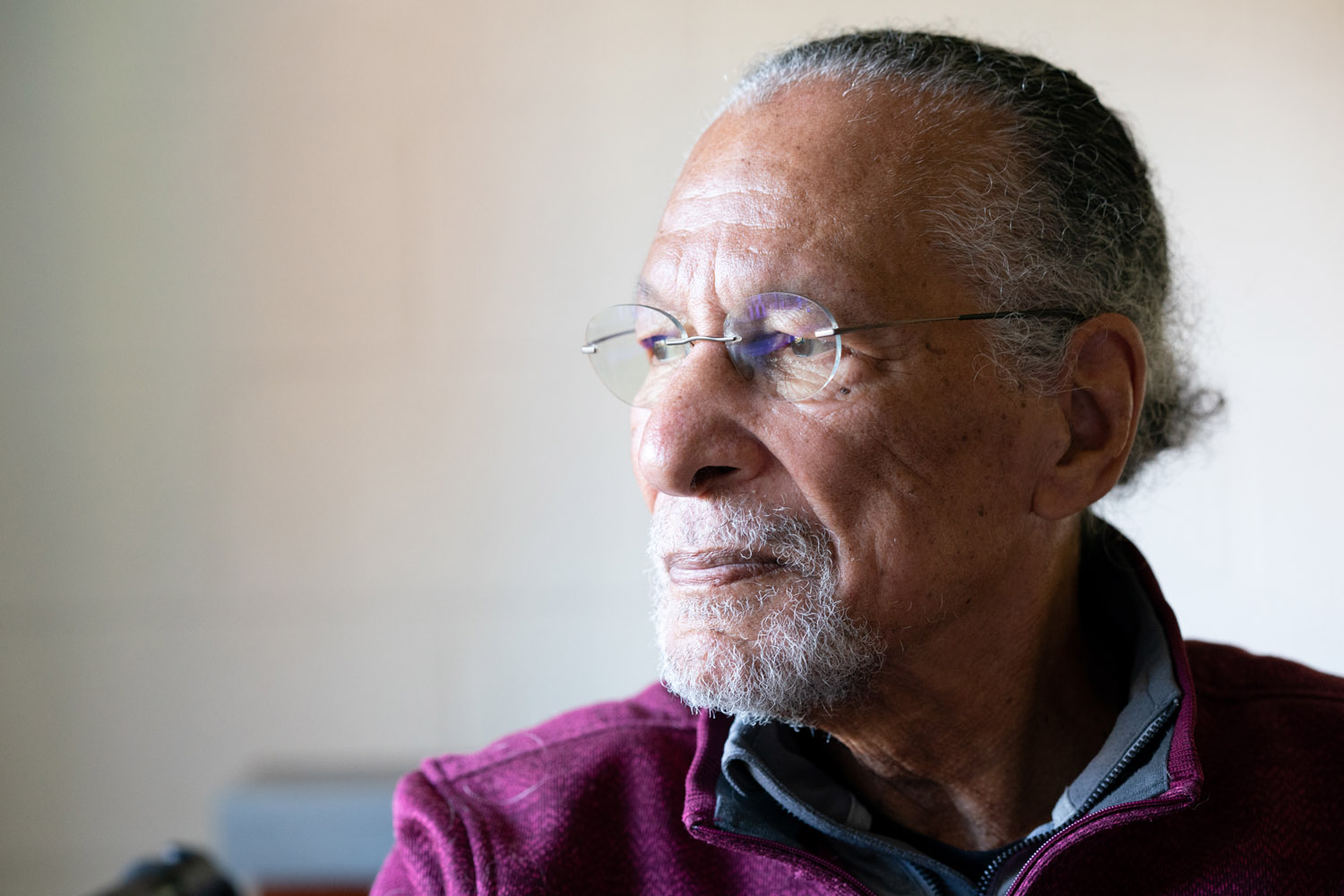
Going beyond the horizon
Jim West has been at the forefront of acoustic science for nearly six decades. During that time, he has been just as passionate about serving as a mentor and diversifying the STEM fields. From his childhood in the segregated South to his recent work on an advanced digital stethoscope, West has always looked for "what exists beyond the horizon."
9 min read
Each month, our Journeys of Innovation series tells the stories of inventors or entrepreneurs whose groundbreaking innovations have made a positive difference in the world. This month we focus on the journey of an inventor with multiple honors, including being featured on a USPTO Inventor Collectible Card.
The amber light of an early fall afternoon fills an office overlooking one of the quads at Johns Hopkins University in Baltimore, Maryland. The office belongs to noted American inventor James Edward Maceo West—or just "Jim" to everyone who knows him. Aside from the walker he uses, there is little about West to suggest his 88 years of age. His hair is pulled back in a small ponytail bun, and he wears blue jeans and an Under Armour pullover. He points to a framed photograph of himself with a young Baltimore public school student.
"Untrained minds are an important commodity," he says.
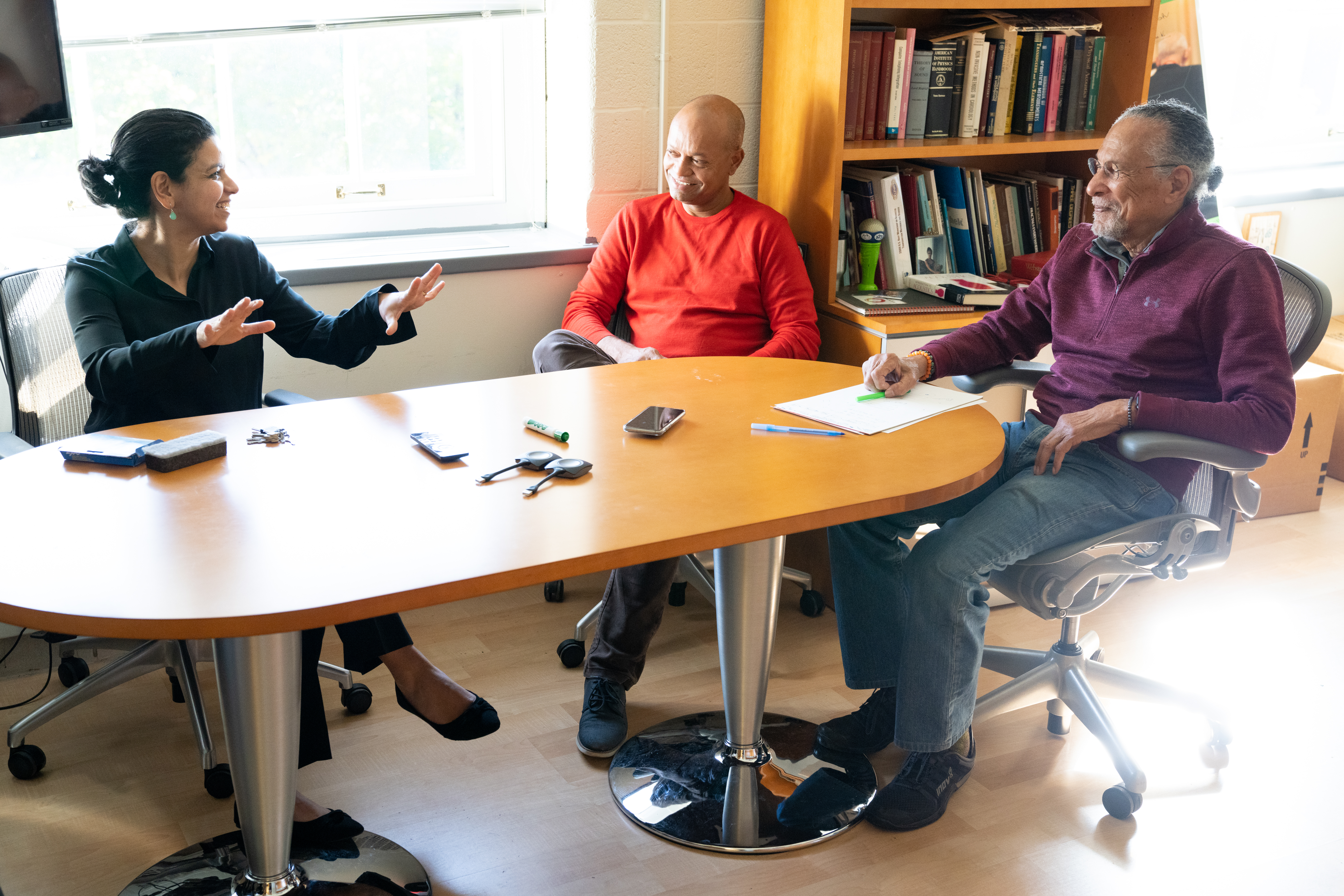
From left, Dr. Mounya Elhilali and Dr. Ralph Etienne-Cummings, both faculty members at Johns Hopkins University's Whiting School of Engineering, discuss work with Jim West in his office.
The picture was a gift from the student, who had done an award-winning project on West, and his prize was meeting the famed inventor. Like many of the students West has inspired and mentored over the years, he expects this young man will go far: "Maybe even [Johns Hopkins]," West says. "Who knows? He's a very bright kid."
From an accomplished inventor like West, this is high praise indeed. Evidence of a lifetime of scientific and technological achievement is scattered across his office: photographs with U.S. presidents, framed magazine covers featuring his face, and numerous awards and trophies. Among the most prized items are the images and objects commemorating his induction into the National Inventors Hall of Fame in 1999 and his receipt of the National Medal of Technology and Innovation from President George W. Bush at a White House ceremony in 2007.
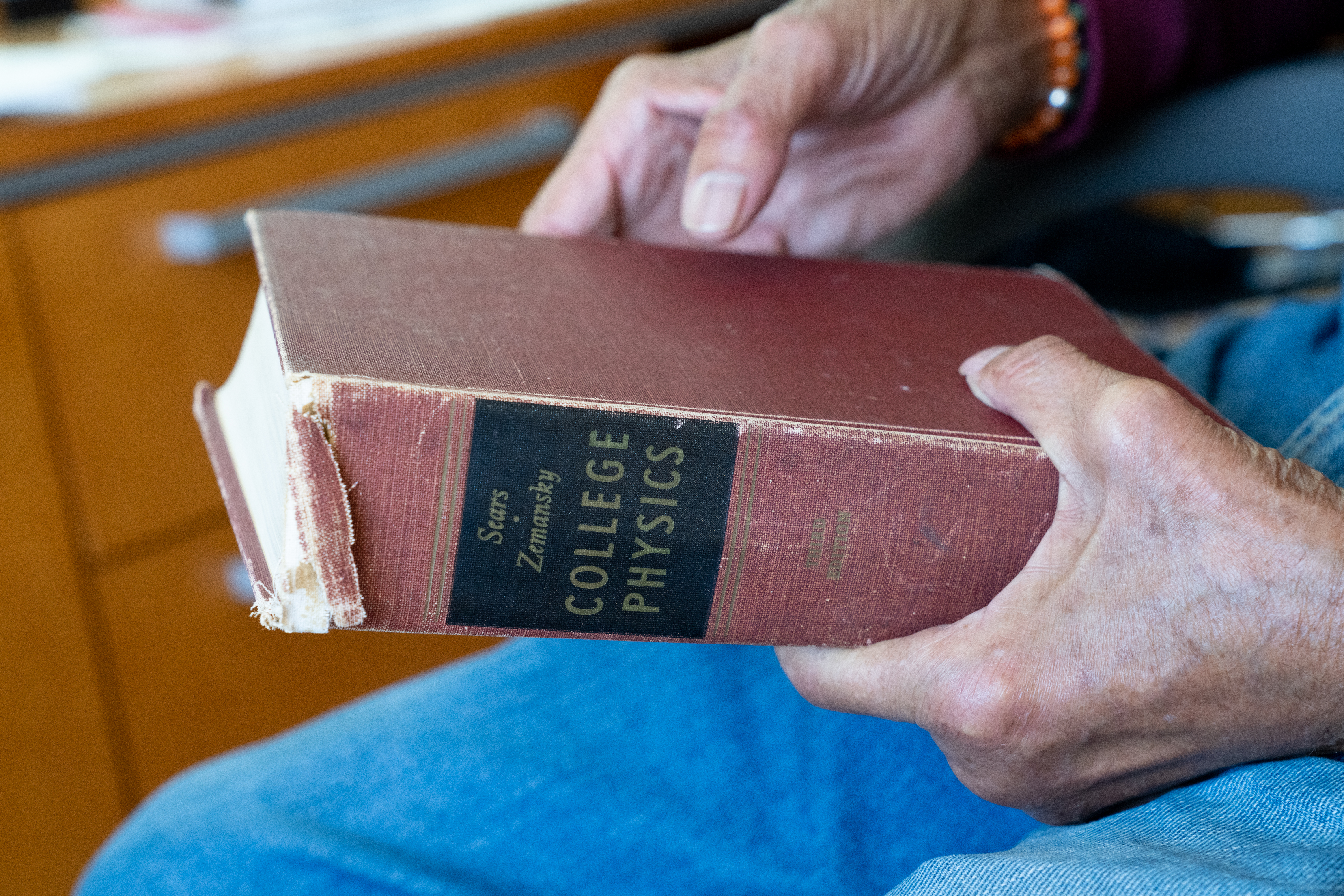
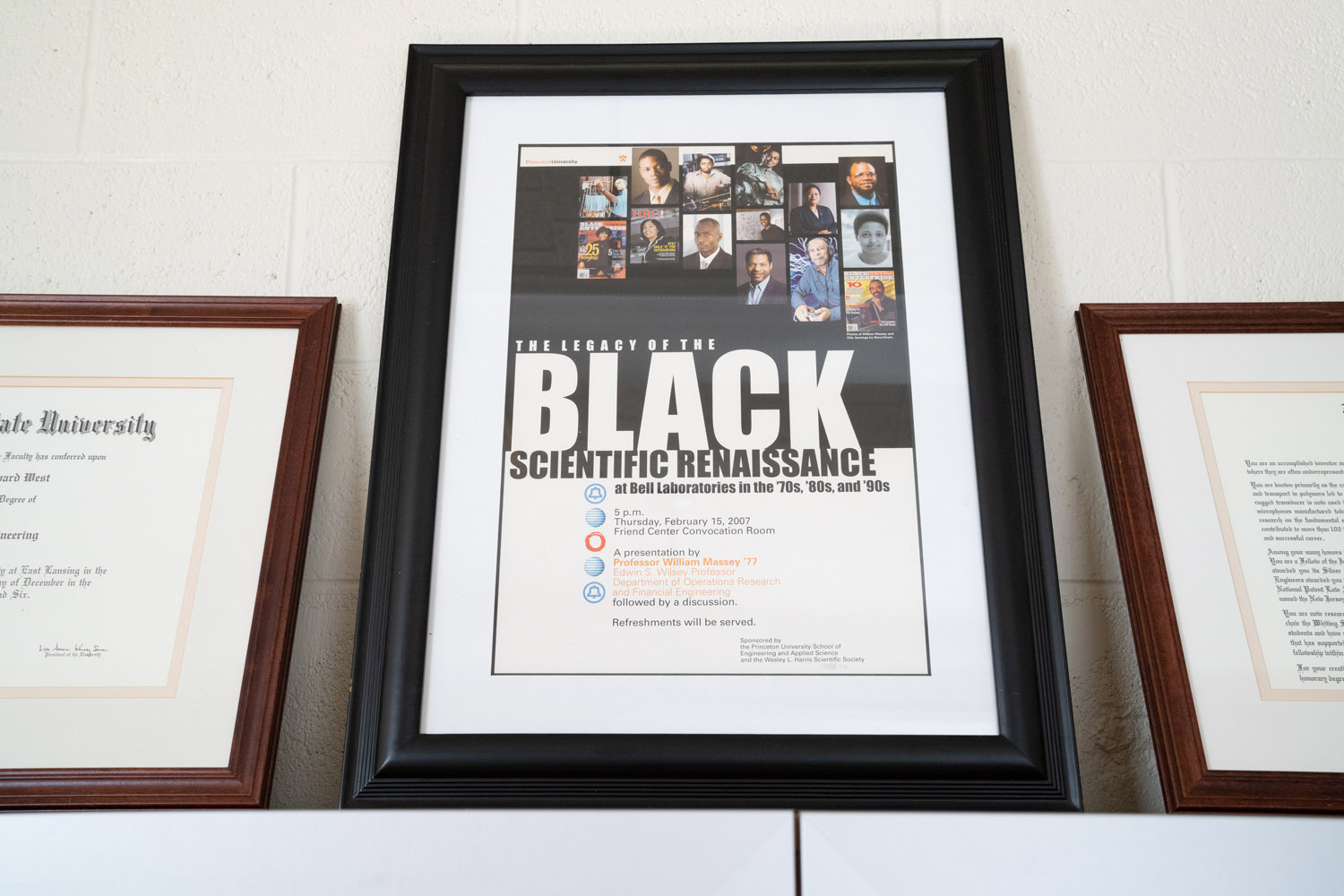
In his office, Jim West keeps a framed poster for an event celebrating notable black inventors as well as a copy of a physics textbook he's had since the early 1960s, when he worked at Bell Laboratories in New Jersey.
Later, in his lab, a small, shiny cylindrical device catches West's eye, and he points it out. It's the instrument that's been his focus for the past few years: a programmable digital stethoscope that can diagnose pneumonia in 10 seconds. West's stethoscope symbolizes not only his ingenuity but also his experience as a mentor—three of his graduate students were co-inventors—and is a marker of a profoundly successful lifelong journey of inventiveness.
Born in 1931 in a home his grandfather built in Prince Edward County, Virginia, West came of age in an era when African Americans regularly faced barriers to education. (Prince Edward County's lack of support for African American high school students was the subject of one of five U.S. Supreme Court cases combined in the 1954 case of Brown v. Board of Education, which paved the way for integration.) Both of West's parents were educators and, unsatisfied with the schools for black children in their community, they moved the family to Hampton, Virginia, for better options.
When his mother went to teach on a Native American reservation in return for her college tuition, West was left in the care of his grandmother for several years. It was during this time that he developed the fundamental qualities—to be both inquisitive and nurturing toward the inquisitiveness of others—that would play a significant role in his life.
Jim West with President George W. Bush after receiving the National Medal of Technology and Innovation at a White House ceremony on July 27, 2007. Image courtesy the George W. Bush Presidential Library and Museum.
As a child, West spent time tinkering with things and opening them up, finding out what made them work. His early investigations involved objects ranging from his grandfather's pocket watch to an old radio someone had thrown out. After West's family discovered the disassembled pocket watch, they knew they had to keep him busy.
"It's always been a part of my curiosity," West says. "Taking things apart is easy. The hard part is putting them back together again."
During his youth, West also learned the value of mentorship and service to others. His grandparents were active in their church and the black community, and relatives often stopped by, many of whom were doctors, lawyers, or dentists. They expected he would choose one of those professions for himself as well. But West had other ideas. He enrolled at Temple University in Philadelphia in 1953 and quickly changed his major from pre-med to physics.
West's father sought to discourage him from earning a degree in science, as many African Americans with advanced degrees in those fields could only find work at post offices or as janitors and porters on railway cars.
"They were doing that because the only jobs that they could find in their field didn't pay enough to support their families," West explains. "Opportunities at universities and in industry were not open to black people at that time."
In college, West was often the only person of color in his classes, and though he says the challenges he faced there were typical of any student, he found it difficult to get into study groups because of his race.
"So my solution was to solve the most complicated problem and throw it at the first [study] group." At that point, they wouldn't raise any objections.
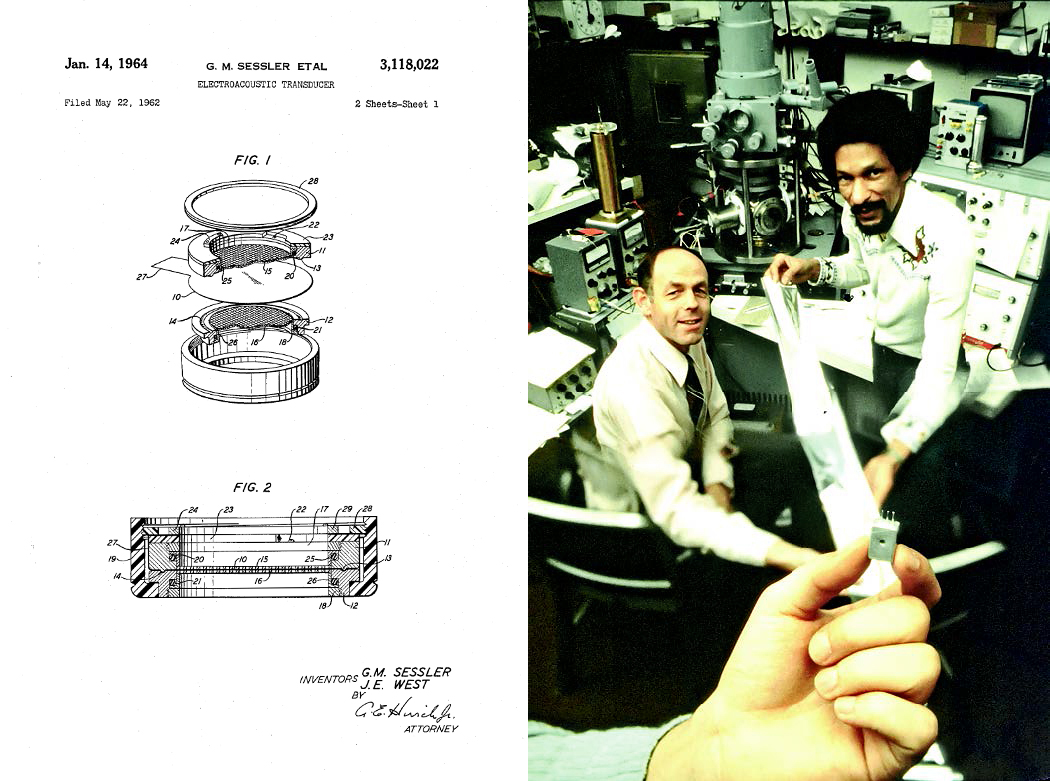
At left: A drawing from the patent for the electroacoustic transducer/electret microphone, granted in 1964. At right: Gerhard Sessler and Jim West holding Teflon foil in their lab, with a production Western Electric EL2 electret microphone in the foreground, 1976. Image courtesy Nokia Bell Laboratories.
One summer, West participated in a research program at Bell Laboratories, the highly acclaimed information technology and communications research company in Murray Hill, New Jersey. He felt comfortable there, excelled quickly, and was offered a permanent position.
"When you put a bunch of nerds together, it kind of normalizes things," West says. "But one of the other reasons that I joined Bell Labs was that I met and saw other black scientists."
"Linc Hawkins joined Bell Labs in 1942, which was before Jackie Robinson broke into baseball. But everybody knows Jackie Robinson; very few people know of Lincoln Hawkins. So he's my hero."
One of them was Lincoln Hawkins, the first African American to work at Bell Labs and a pioneer of polymer chemistry. Widely known for developing durable outdoor sheathing for telephone wires, Hawkins was inducted into the National Inventors Hall of Fame in 2010. He was West's mentor at Bell Labs.
"Linc Hawkins joined Bell Labs in 1942, which was before Jackie Robinson broke into baseball. But everybody knows Jackie Robinson; very few people know of Lincoln Hawkins. So he's my hero," West says. Hawkins was instrumental in recruiting other minorities to Bell and the sciences in general, and those efforts helped instill the same drive for equality and mentorship in West.
While at Bell, West co-invented, with Gerhard Sessler, the foil-electret microphone in 1962. Perhaps one of the most pervasive pieces of technology of the modern era, electret microphones represented a leap in acoustics. They could be made extraordinarily small compared to their predecessors, and they were durable and highly sensitive without requiring a battery source like most other microphones in use at the time, thus enabling a near-limitless range of applications. By current estimates, more than two billion electret microphones are manufactured every year as components in everything from headsets and smartphones to hearing aids and tablets.
West stayed at Bell Labs (now Nokia Bell Labs) for 40 years until he retired and took a position as a research professor at Johns Hopkins in 2002. While he was perhaps most renowned for the foil-electret microphone, he worked on many other projects focusing on the physics of sound. He improved communications between Formula One race car drivers and their crews, addressed the poor acoustics in Lincoln Center's David Geffen Hall, and found ways to mitigate noise levels in Johns Hopkins Hospital wards. He also partnered with NASA to develop a lightweight, automated vest to monitor the health of astronauts.
Today, West's name is listed on more than 250 U.S. and international patents. As a distinguished innovator, he is often in demand for news stories and appearances, but it's working with students in his lab at Johns Hopkins that he enjoys most.
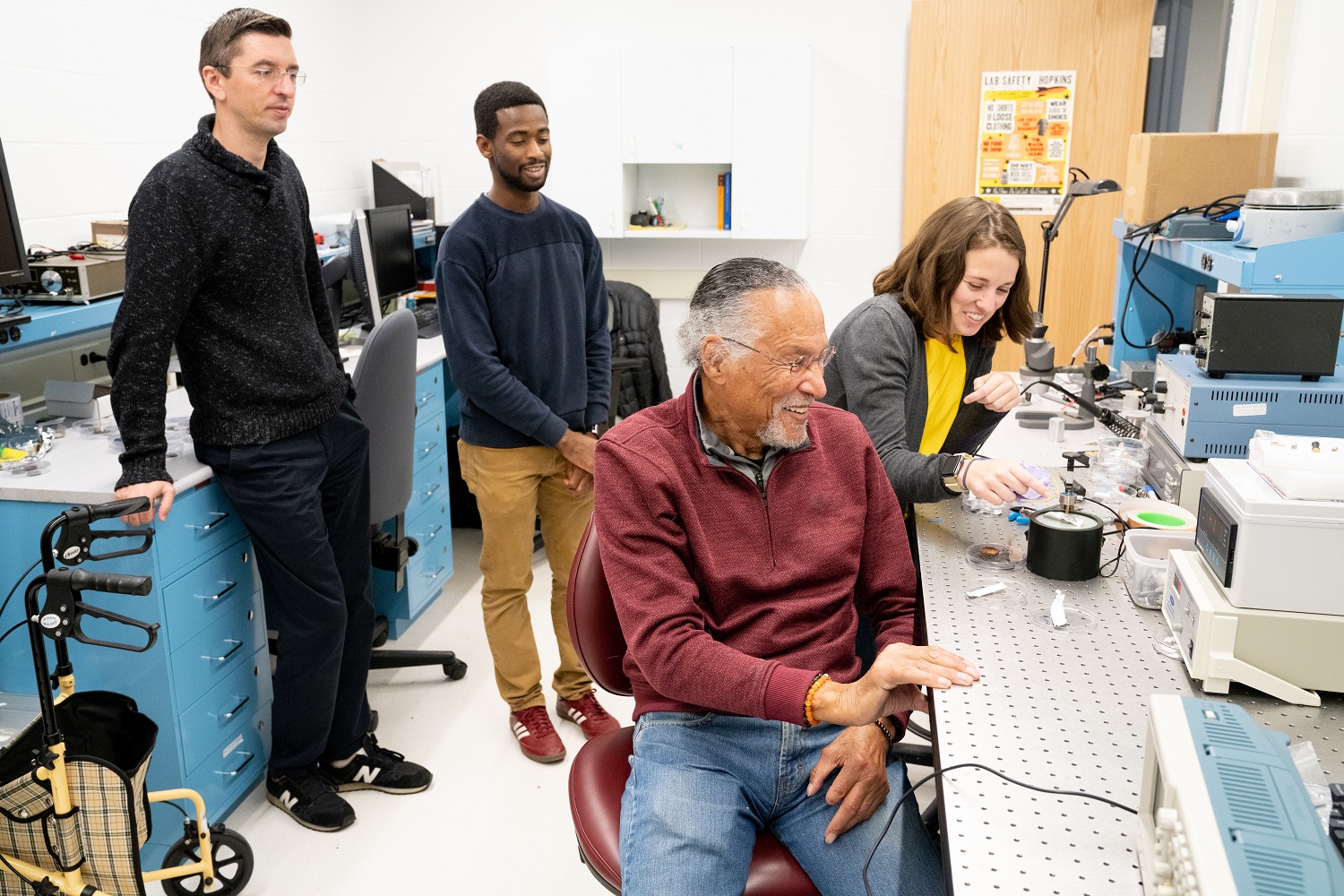
Jim West collaborates on a project with graduate students in his lab at Johns Hopkins University.
The programmable digital stethoscope West and his graduate research students co-invented has taken about five years to reach the early stages of commercialization, but it couldn't be more timely. According to the World Health Organization, pneumonia is the largest infectious cause of death in children worldwide, killing approximately 800,000 people under the age of 5 each year, mostly in the developing world, where access to quality healthcare and critical early diagnoses are limited.
Just like a doctor, the digital stethoscope "listens" to and analyzes a patient's breathing to diagnose pneumonia and other respiratory problems. West's team of graduate students developed a special membrane inside the chest piece of the stethoscope that is better than its predecessors at filtering out interferences. The instrument can be used by anyone and returns a diagnosis in 10 seconds. It accurately identifies pneumonia 91% of the time, the same success rate as that of well-trained physicians and nurses.
West's daughter developed a company named Sonovi to commercialize the digital stethoscope, and today Sonovi has already distributed 100 of them in five countries in Africa. The users, in turn, are gathering important data to help fine-tune the device.
West's graduate students come from all backgrounds, reflecting the diversity he values and emphasizes in science. One of them, doctoral student Ian McLane, has now been working with West for seven years and is one of the digital stethoscope's co-inventors. He says West provides students with the space to experiment, never setting rigid boundaries for their work or telling them exactly how to do things.
"He gives us freedom," says McLane.
West also works with students at Baltimore Polytechnic Institute, a STEM-focused public high school in north Baltimore a few miles from his Johns Hopkins office.
West became involved in mentoring students at the school six years ago through the Ingenuity Project, an accelerated math, science, and research program for Baltimore's high-achieving public middle and high school students. West's impact has been twofold. On the one hand, he works with the students on science projects, but on the other, he focuses heavily on access to the program and its overall diversity.
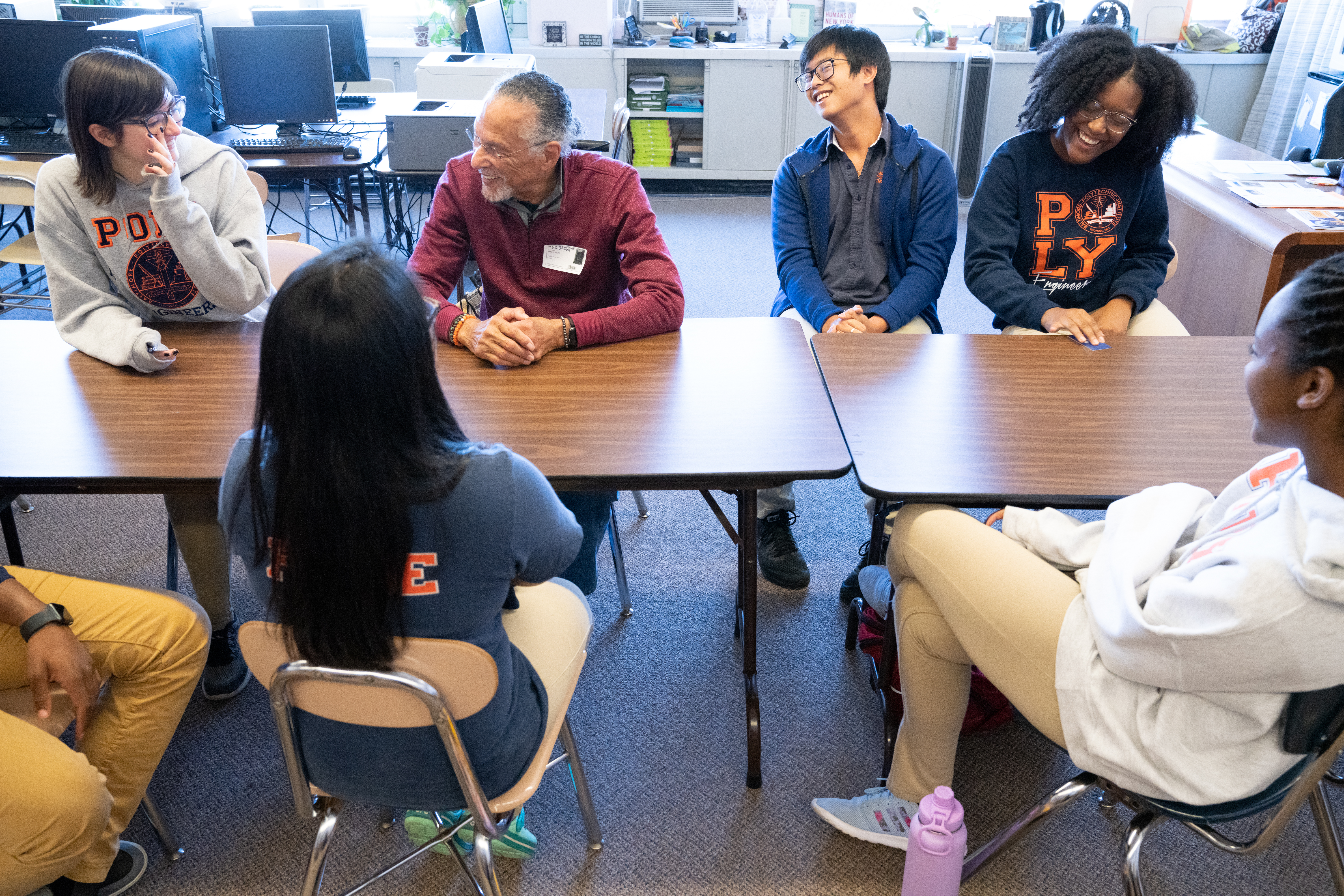
Jim West meets with Dr. Nicole Rosen’s senior research class at Baltimore Polytechnic Institute. The students are participants in the Ingenuity Project, which is designed to help them excel in STEM fields. During the Research Practicum experience, students work with mentors at Baltimore area colleges, universities, and other research institutions to develop independent research projects.
When asked to join the Ingenuity board, he agreed on one condition: "I said only if the board is willing to commit to making this program look more like the city of Baltimore." Indeed, over the past three years students from underrepresented minorities have increased from 38 to 56% of the Ingenuity Project's enrollment, with approximately half being female.
On one particular visit to Baltimore Polytechnic Institute, West calls on students, inviting them to give a short elevator speech on their research. They casually toss terms like "HIV-1 mutant transfer," "liquid crystals," "neuroactivity," and "toxic waste superfund sites" back at him in their pitches. West asks each student follow-up questions and offers a few witticisms to put them at ease.
At one point, West asks how many of the students have submitted their work to a prestigious nationwide math and science competition for high school seniors. Nearly all raise their hands.
West spurs the students on with words of encouragement and just enough practical advice to get them thinking about the direction of their next move, but not the ultimate destination. Although he doesn't use these exact words, his advice channels the same spirit as a quote by Alexander Graham Bell that West encountered every day above the foyer at Bell Labs: "Leave the beaten track behind occasionally and dive into the woods."
"From the standpoint of technology," West explains, "You never know what exists beyond the horizon if you don't go to the horizon, right? And so, that's one of the mantras that I live by. And it frequently doesn't lead anywhere, but when it does, it's a eureka moment, and those are what we all work for."
Credits
Produced by the USPTO's Office of the Chief Communications Officer. For feedback or questions, please contact inventorstories@uspto.gov.
Story by Alex Camarota. Contributions from Marie Ladino, Jay Premack, Eric Atkisson, Rebecca Fritchman, and Linda Hosler. Unless otherwise noted, photos by Jay Premack.
References
Douglas Birch, "Making Waves." Johns Hopkins Whiting School of Engineering Magazine, Winter 2017. https://engineering.jhu.edu/magazine/2017/01/making-waves/#.Xd1SNyNKhaQ.
"Pneumonia." World Health Organization, August 2, 2019. https://www.who.int/en/news-room/fact-sheets/detail/pneumonia.


